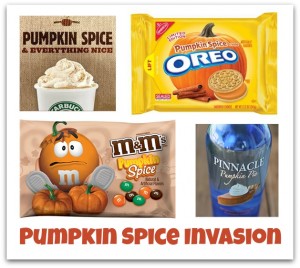It started with the Starbucks Pumpkin Spice Latte. Now, it seems like everything is pumpkin-kissed this time of year.

And that’s just a drop in the bucket. Pumpkin-flavored foods earned $308 million in the U.S. in 2013. What’s up with continuing, annual trend? Industry watchers theorize that it’s all in the marketing. Starbucks hypes the fall release of its trendsetting Pumpkin Spice Latte like an event, and then pulls it after a few months, creating a “must buy now” effect. The beer companies have stressed marketing their beers to women, who their research says prefer sweeter brews, like the pumpkin ones.
One pumpkin item that has dropped, ironically enough? Pumpkins. According to the USDA, the average American in 1998 ate 6.5 pounds of pumpkin each year. In 2012, that number dropped to 5 pounds. That’s because it’s not pumpkins we love, it’s pumpkin spice. The PSL at Starbucks contains no pumpkin, but the spice blend most associated with pumpkin pie: cinnamon, allspice, and cloves, for example.
To keep up with demand, Starbucks rolled out the PSL in September, its earliest ever launch. McDonald’s has its own take on the drink as well. Other pumpkin (spice) products now available: Pumpkin Spice M&Ms, Pumpkin Spice Oreos, Pumpkin Spice Jell-O, pumpkin treats at Dunkin’ Donuts, pumpkin cheesecake ice cream at Baskin-Robbins, and Pinnacle’s Pumpkin Pie Vodka. It’s not even just for humans. There are two special pumpkin blends now available of Purina Dog Chow.
When will the craze finally die down? Probably around Christmas…and then it’ll come right back next fall.







